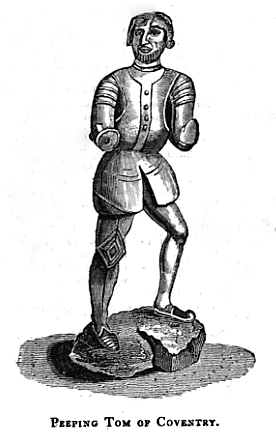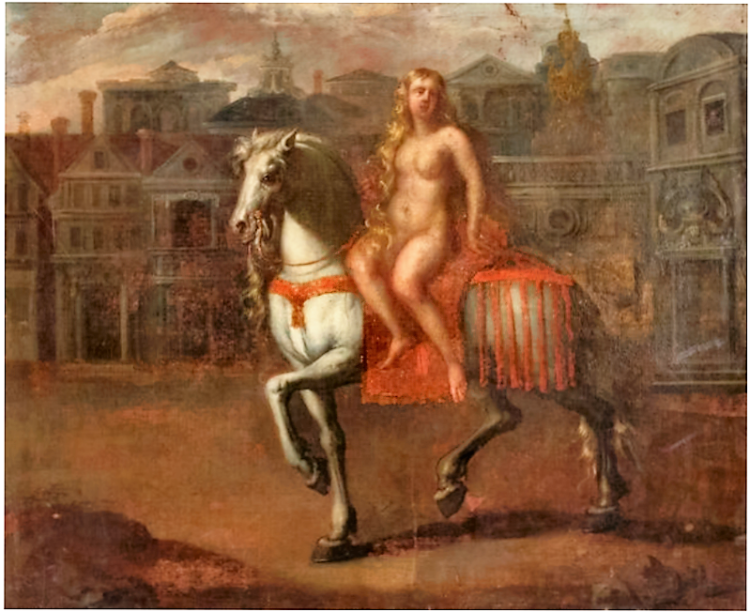
A drawing of Peeping Tom, in the exact state in which he is carved, but divested of all paint and superfluous ornaments.
W. Reader in The Gentleman’s Magazine: and Historical Chronicle (London) of July 1826
The Coventry Peeping Tom statue, which dates from around 1500, survives today. Though it is now stripped down to the oak, over the years it had accumulated many layers of paint. At some early point its two arms were removed for better maneuvering in and out of windows, and parts of it have been gouged away, perhaps by souvenir seekers. Sources extending back to 1765 record expenses for a wig and painting of the statue to prepare it for the Great Show Fair.
Daniel Donoghue in Lady Godiva: A Literary History of the Legend (2003)
In A Concise Dictionary of Phrase and Fable (1993), B. A. Phythian writes:
Leofric, Earl of Mercia and one of the most powerful men in England during the first half of the 11th century, imposed certain taxes which his wife, Lady Godiva, patroness of Coventry, asked him to remove. He promised to do so if she would ride naked through the city, which she accordingly did in 1040.
But most medieval scholars agree that the ride never took place. In Lady Godiva: A Literary History of the Legend (2003), Daniel Donoghue, professor of English and American literature and language, explains that contemporary historians did not consider Godiva particularly noteworthy; what little was written about her at the time mentioned her merely as the wife of a famous man. He points out that two centuries after her death, chroniclers in the Benedictine abbey of St Albans inserted a fully developed narrative into their Latin histories: the legend of Lady Godiva was born. The following is from Flores Historiarum (Flowers of History – completed in 1235?), by Roger de Wendover (died 1236), a monk at the abbey of St Albans:
(1849 translation by J. A. Giles)
The countess Godiva, who was a great lover of God’s mother, longing to free the town of Coventry from the oppression of a heavy toll, often with urgent prayers besought her husband, that from regard to Jesus Christ and his mother, he would free the town from that service, and from all other heavy burdens; and when the earl sharply rebuked her for foolishly asking what was so much to his damage, and always forbade her ever more to speak to him on the subject; and while she, on the other hand, with a woman’s pertinacity, never ceased to exasperate her husband on that matter, he at last made her this answer, “Mount your horse, and ride naked, before all the people, through the market of the town, from one end to the other, and on your return you shall have your request.” On which Godiva replied, “But will you give me permission. if I am willing to do it?” “I will,” said he. Whereupon the countess, beloved of God, loosed her hair and let down her tresses, which covered the whole of her body like a veil and then mounting her horse and attended by two knights she rode through the market-place, without being seen except her fair legs; and having completed the journey, she returned with gladness to her astonished husband, and obtained of him what she had asked; for earl Leofric freed the town of Coventry and its inhabitants from the aforesaid service, and confirmed what he had done by a charter.
An edict forbidding the town’s citizens to gaze on Godiva during her ride was added to the legend. In A chronicle at large, and meere history of the affayres of Englande, and kinges of the same (1569), a paraphrase of the lost medieval chronicle of Prior Geoffrey, Richard Grafton (circa 1507-1573) wrote:
Gaufride [= Geoffrey] sayth that this gentle and good Lady […] called in secret maner (by such as she put speciall trust in) all those that then were Magistrates and rulers of the sayde Citie of Couentrie, and vttered vnto them what good will she bare [= bear] vnto the sayde Citie, and how shee had moued the Erle her husband to make the same free, the which vpon such condition as is afore mencioned, the sayde Erle graunted vnto her, which the sayde Lady was well contented to doe, requiring of them for the reuerence of womanhed, that at that day and tyme that she should ride (which was made certaine vnto them) that streight commaundement should be geuen throughout all the City, that euerie person should shut in their houses and Wyndowes, and none so hardy to looke out into the streetes, nor remayne in the stretes, vpon a great paine, so that when the tyme came of her out ryding none sawe her, but her husbande and such as were present with him, and she and her Gentlewoman to wayte vpon her galoped thorough the Towne, where the people might here [= hear] the treading of their Horsse, but they saw her not, and so she returned to her Husbande to the place from whence she came, her honestie saued, her purpose obteyned, her wisedome much commended, and her husbands imagination vtterly disapointed.
Soon, this change in plot provoked the invention of a character who defies the edict and is consequently mysteriously punished with blindness or death. One of the earliest references to a voyeur is from A relation of a short suruey of 26 counties, a journal kept by three soldiers of Norwich during a tour of England in 1634; they are visiting a hall near the cathedral of Coventry:
(1904 edition)
A fayre large Hall there is, ouer against their fayre Church, with a stately ascending entrance, the vpper end adorn’d with rich Hangings, and all about with fayre Pictures, one more especially of a noble Lady, whose memory they haue cause not to forget, for that shee purchas’d, and redeem’d their lost infring’d Liberties, and Freedomes, and obtain’d remission of heauy Tributes impos’d vpon them, by vndertaking a hard, and vnseemely taske, which was, To ride naked openly, at high Noone day, through the City, vpon a milke white steed, which she willingly perform’d, according to her Lords strict iniuction : It may bee very well discuss’d heere, whether his hatred, or her Loue exceeded, her fayre long hayre did much offend the wantons glancing Eye.
The wording leaves it unclear whether the word wanton refers to an inhabitant of Coventry or to Leofric himself, since, in the above-mentioned chronicle by Grafton, the earl is presented as relishing the thought of his wife riding naked in the public streets.
The painting that the soldiers describe is most probably Lady Godiva (1586), by Adam von Noort. It shows Lady Godiva riding through the empty streets, and a bearded man looking out an upstairs window from a building on the right-hand side. This man is probably Leofric, but his identity is not obvious, which might have contributed to the emergence of the figure of the voyeur.

Lady Godiva (1586), by Adam van Noort – image: Wikiwand
A mention of a person peering at Lady Godiva is made in a manuscript volume of annals of the city of Coventry from the second half of the 17th century; the manuscript in which this passage occurs is copied from an older manuscript which seems to date back to the 16th century:
The Franchisment and Freedome of Coventry was purchased in manner Following. Godiua the wife of Leofric Earle of Chester and Duke of March requesting of her Lord freedome for this That Towne, obtained the same upon condition that she should ride naked through the same; who for the Love she bare to the Inhabitants thereof, and the perpetuall remembrance of her Great Affection thereunto, performed the same as Followeth. In the forenoone all householders were Commanded to keep in their Families shutting their doores and windows close whilst the Dutchess performed this good deed, which done she rode naked through the midst of the Towne, without any other Coverture save only her hair. But about the midst of the Citty her horse neighed, whereat one desirous to see the strange Case lett downe a Window, and looked out, for which fact or for that the Horse did neigh, as the cause thereof, Though all the Towne were Franchised, yet horses were not toll-free to this day.
Eventually, the voyeur was provided with an occupation; in the above-mentioned book, Daniel Donoghue explains:
As a tailor he would conveniently be equipped with an awl to bore a viewing hole, but the occupation would be appropriate for other reasons as well. Proverbially, tailors were thought to be less than fully men even to the point of suggesting their emasculation (“Nine tailors make the man”). So, for example, when a tailor in a fairy tale accomplishes something heroic, his deficient manhood throws the magical transformation into greater relief. In addition, the tailor’s business of making clothes, in contrast to Godiva’s nakedness, may have added to the thematic appeal.
The voyeur also acquired a name. The earliest known occurrence of the term peeping Tom is found in the anonymous book titled A full and particular Account of the Life and notorious Transactions of Roger Johnson (1740):
Early in the Morning, the Heath swarms with Horses and Dogs, as the Land of Egypt did formerly with Locusts, where each one pursues the Bent of his Inclinations, generally comprised under the three following Classes; some Hunt, some Course, and the rest stand gaping (like peeping Tom of Coventry) at the Race Horses, taking their Morning Sweats, who are so swaddled up, that were they not a distinct Part of the Creation, any reasonable Man wou’d take them for so many Egyptian Mummies raised from the Dead.
I have discovered an instance of peeping Tom in its generic sense of voyeur which predates those recorded by the Oxford English Dictionary (3rd edition, 2005); The Caledonian Mercury (Edinburgh) of Saturday 7th March 1767 published a letter in which ‘Modestas’ wrote:
A PLAN to prevent W———G.
So many complaints have been made of late about the increase of wh—d—m in this kingdom, that I have turned my thoughts to enquire into the cause of this encrease [sic], and to provide a remedy: I think I have succeeded in both.
The cause is certainly owing to the well known fashion among the ladies, of employing a man in almost every occupation that used to be followed by women: The tirewoman [= lady’s maid] of twenty years ago is a frisseur [= friseur, hairdresser]; the midwife, strange as the name appears, is a man. A man now throws his arms about the waiste [sic] of every Venus de Medicis, to take her measure for stays: The he-mantua-maker tries on her gown, while her tempting neck lies bare to his eyes and hands; and peeping Tom is now employed to try on her shoes.
